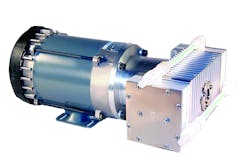Transfer pyrophoric processing media with safety
When manufacturing pyrophoric processing gases — highly reactive gases that ignite upon contact with air — it is crucial each system component be sufficiently sealed.
In one instance, evidence of trace air leakage was discovered in the pump head of a diaphragm gas-sampling pump. A change of materials enabled the pump manufacturer to meet increased gas tightness requirements imposed by actual operating conditions.
Air Products is a leading international manufacturer of industrial gases and chemicals. With a staff of more than 21,000, the company, based in Pennsylvania, operates in 50 countries across the globe and supplies a wide variety of processing media for myriad applications and industries.
Among goods produced specifically for the semiconductor and solar industry, Air Products manufactures a special gas mixture employed in etching and gas deposition processes to coat silicon wafers and glass substrates; these methods help, for example, to create the active films in flat panel displays and solar cells.
Owing to their pyrophoric properties, the utmost care is required both when manufacturing and using these gases. Should such gases come into contact with air, an exothermic reaction takes place in which an oxidation product is created and deposited in the form of a white coating. All system components that store or transfer the gases must therefore prevent air contamination.
A simple principle
In the Air Products production plant, gas is transferred via a series of pumps consisting of a molecular drag pump and a downstream diaphragm pump. The role of the diaphragm pump here is to generate a rough vacuum of around 2 mbar in preparation for further evacuation by the upstream turbo-molecular pump, which as a result operates more efficiently and achieves a deeper vacuum. The pump employed is a chemically resistant diaphragm gas pump manufactured by KNF.
Diaphragm pump operation is based on a simple principle: An elastic diaphragm, which is clamped securely around the edge, is moved up and down in the center by an eccentric cam. This action pumps the medium across automatic valves. This working principle has several advantages relevant to the application described here: On the one hand the medium is not contaminated, as the pumps are oil free. On the other, diaphragm pump features make them extremely gas tight. A further advantage lies in the longevity of the patented, KNF stress-optimized structured diaphragm.
Air Products opted to use a standard pump type UN860.3 FTI Ex for their pyrophoric gas application, a pump developed for the North American market. Both the diaphragm itself and the pump head are fabricated from the chemically resistant plastic polytetrafluoroethylene (PTFE), while the valves are made from the PTFE-like fluorinated elastomer FFKM. The motor driving the pump complies with the U.S. and Canadian explosion protection standards NEC/CEC, and the connections conform to the U.S. NPT standard. The pump has a maximum flow rate of 60 l/min, and achieves a maximum vacuum of 1.5 mbar.
Continuous maximum load
Thanks to its gas tightness, the pump type selected by Air Products is one of the most sought-after models for comparable applications. Routine checks performed after one-and-a-half years in operation, however, revealed slight traces of a white coating around the valves. Minor discoloration could also be seen on the top plate of the diaphragm pump.
Subsequent analysis of the operating data showed that the diaphragm gas pump was permanently working in its maximum vacuum load range. This led to the suspicion that the PTFE head was allowing minute amounts of air into the pump, following a lengthy period of duty at particularly high levels of continuous stress.
To solve the problem, KNF redesigned the pump head, replacing the PTFE top plate with a plate made from stainless steel (AISI 316 – with added molybdenum for increased resistance to chemical corrosion). Owing to the high rigidity of steel, slight deformations will no longer occur. To further ensure leak tightness to level needed in this application, O-rings were added to isolate the valve seats and prevent air from reacting with the media.
The modified diaphragm gas pump has been back in use for around two years now — and the white coating described has not appeared since. The same change in materials has also been completed on the pump head plate of a second diaphragm pump, which Air Products keeps in reserve for this production.
When specifying pumps in process industry applications, it is essential that they be fully adapted to the specific needs of the process itself, operating conditions, and properties of the media employed. As a result, every pump application requires a review to ensure optimal design — from how each pump head, diaphragm and valve is configured and constructed, to the materials used and the motor selected.
Rich Aerts is process-pump product engineer at KNF Neuberger Inc., New Jersey.
Modular systems, comprising tried and tested components and materials, enable project pumps to be quickly made to precise specifications and in small quantities. Having realized some 30,000 solutions around the world, and with an extensive product portfolio of application-specific pumps and systems, KNF has been a technology leader for decades. Clients across the globe trust KNF for durable and reliable products for a wide range of applications.
